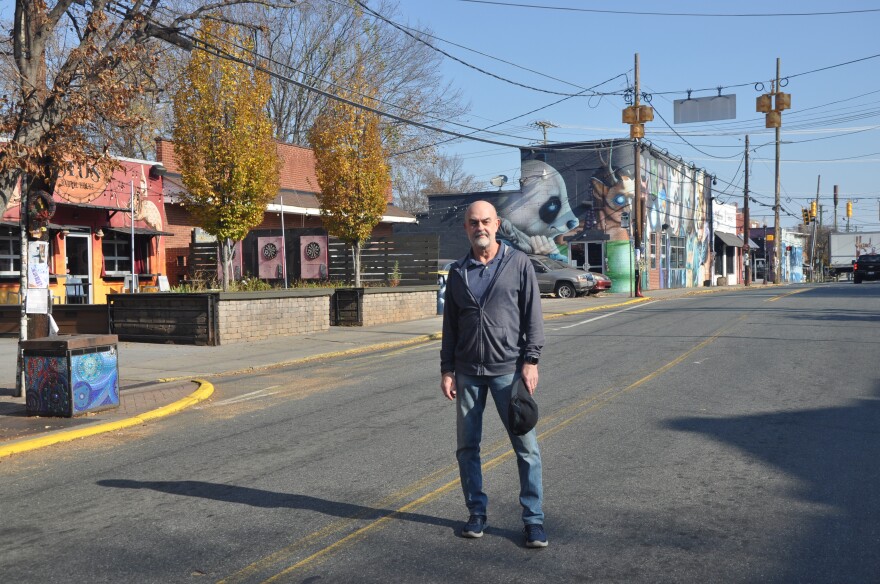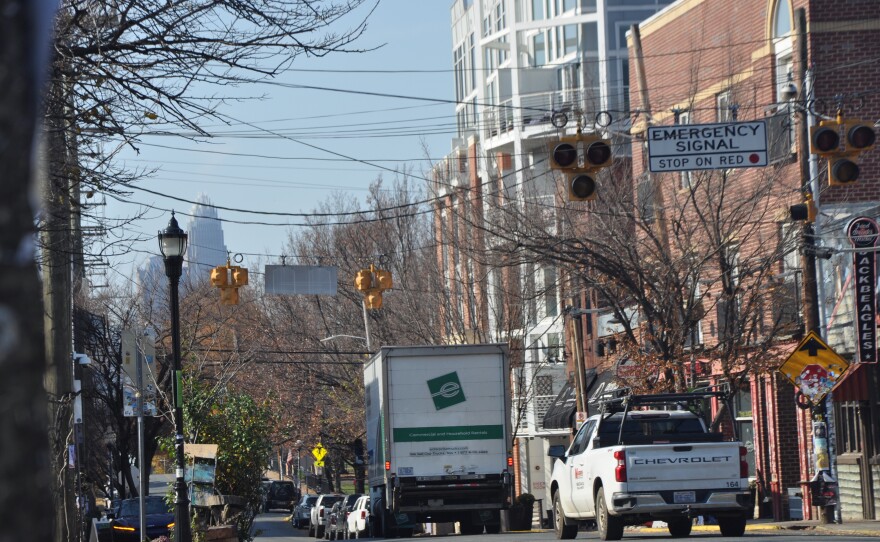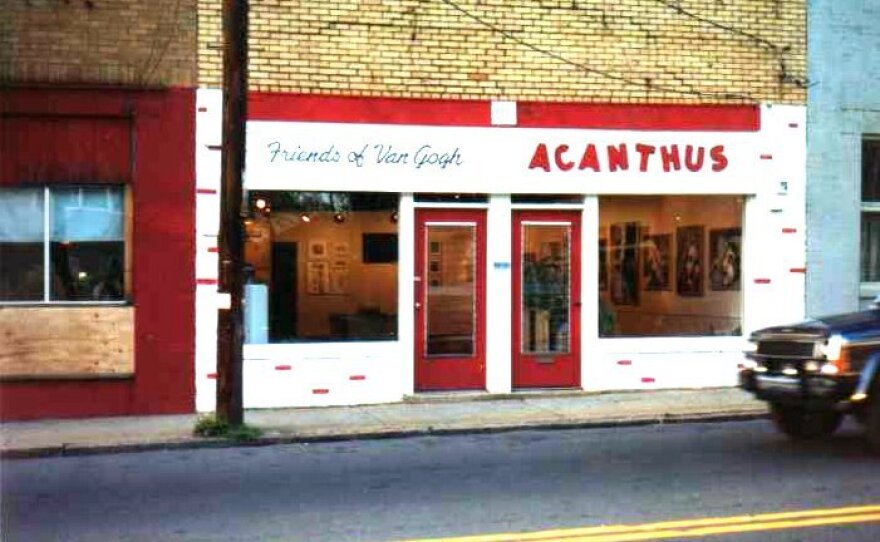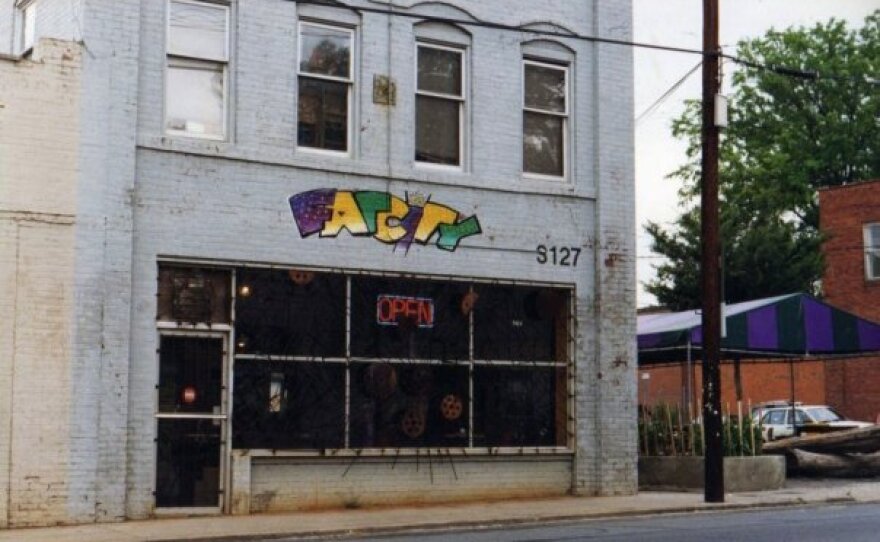There may be no better place to see the tremendous change Charlotte has undergone the past few decades than in NoDa.
Today, the neighborhood is bustling with restaurants, bars, and music venues. Modern apartment complexes line the light rail, which slices through the neighborhood before the stop at 36th Street. A block away, 36th crosses North Davidson Street to form the neighborhood's main intersection.
Jerry Kirk is a Charlotte artist. “Back in the early '90s, you would not have seen much here at all,” Kirk said. Kirk was one of the people who helped create the NoDa art district in the 1990s, the seeds of today’s neighborhood. He’s written a new memoir about it. It’s called “Memories of NoDa.”
“We’re in front of the Evening Muse and right up the road, one block away, is the Neighborhood Theater,” Kirk said. “These are the holdovers from what I call NoDa chapter one. Everything else around them is new, just in the last decade or so. Back in the early '90s, there was nothing up here. Everything else that took place in NoDa was in the opposite direction towards 34th Street.”
Back then, Kirk and other artists were drawn to this forgotten area a few miles north of Uptown because of the cheap real estate they could turn into galleries. The first to come along was called Center of the Earth, which was located on North Davidson in the building that today houses businesses like Pura Vida and Mac Tabby Cat Café. Other galleries followed, including spaces Kirk helped set up across the street next to what was then the neighborhood dive bar called Pat’s Time For One More.
“So right there immediately you had this little pocket of the arts, this tiny little corner where there was galleries and gallery crawl happenings,” Kirk said.
Someone came up with a name for the burgeoning little art district, shortening North Davidson to NoDa. As more and more people came to take part in the gallery crawls, Kirk and his fellow artists found themselves taking on another role in the neighborhood: night watchmen.
“Even in the mid-90s when things were rolling, there’s still a lot of crime happening,” Kirk said.
“One of the things that we did as a way to kind of fight that is we formed a security patrol. We bought black truckers’ hats with the word 'security' emblazoned on them. We had big black flashlights. As a group, we would patrol the street between 36th and 34th, shining our flashlights into cars, letting the neighborhood know we were there and on watch. Within a month after doing that, car break-ins and that sort of crime dropped off.”
The crowds continued to swell. And when the artists thought NoDa could not get any bigger, along came the restaurant Fat City.
“And the neighborhood just exploded,” Kirk said. “It was the one missing element the neighborhood needed. It was a music venue. The food was great. Perfect location. Prior to that, it was mostly people coming down to see art, hang out, and have fun. But Fat City brought down people from all of the outlying communities and counties. Fat City drew the crowds.”
With the new attention, though, the character of NoDa slowly began to change. Kirk says it started when the owner of the buildings containing two art galleries and the bar Pat’s Time For One More sold the properties to developers.
“They tore it down,” Kirk said. “It left a big hole in the center of NoDa. So by 2002, NoDa chapter one was pretty much wrapping up.”
More developers began to take notice. NoDa began to look less and less like an art district as the galleries closed and new restaurants and shops opened. Apartments sprang up everywhere. The light rail came through in 2018. More and more mill houses in the surrounding neighborhoods have been sold, renovated, torn down and replaced. Kirk’s not bitter about what was lost, but does say it’s not quite the same.
“I still enjoy it,” Kirk said. “I think NoDa is a great place. It’s a bit too congested, too crowded, especially on the weekends. It gets a little crazy, kind of a circus-like atmosphere. It was that way in the '90s, but only during the crawls. Now it’s probably one of the most exciting neighborhoods in Charlotte. But it’s not an art district.”
And he adds he doesn’t think the magic of the NoDa of the 1990s could happen now in Charlotte.
“For our two gallery spaces, we paid $400 a month rent,” Kirk said. “You can’t find that anywhere that I know of in Charlotte. It happened more because of the economics of the area. I don’t know, man. It was just the coming together of so many different things. I just don’t see that could ever happen again. I don’t.”
Before we go, Kirk shows me one more thing. On a brick wall behind Cabo Fish Taco is a fading white mural depicting the doorway to a fictional art gallery and a sign with the faint letters N O D A.

“This was the first public display of the word NoDa ever,” Kirk said. “Right here.”
It’s one of the few remaining pieces of the NoDa of the 1990s. The NoDa Kirk and his friends built.













